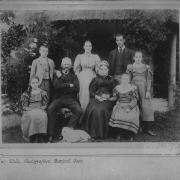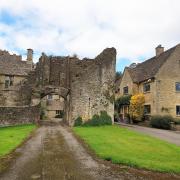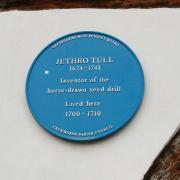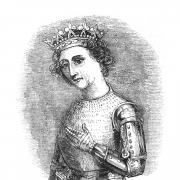With eight Lancaster bombers lost out of 19, and 53 courageous crew killed, including Leamingon Spa-born Henry Maudslay, the 617 Squadron of the famed Dambusters raid paid a high price
He’s not to be confused with two other famed individuals who carried the name ‘Henry Maudslay’, the Georgian engineer (an ancestor) or the Victorian/Edwardian pathologist. They both lived to a fairly decent age for their time, but our Henry Maudslay certainly did not, cut down before his life had firmly taken root. He was RAF pilot Henry Maudslay DFC (1921-43) who died on the celebrated Dams Raid in May 1943.

Maudslay was born in Leamington Spa on July 21, 1921 when one world war had been over less than three years. When Henry Eric joined the clan there was probably little thought that his young life would be defined by a second world war in a generation. He came into the world at 1 Vicarage Road, Lillington, the third child of Reginald Maudslay, an engineer and motor manufacturer, and Gwendolen.
Education-wise, Maudslay was in Gloucestershire in 1930 at Beaudesert School, a prep school in Minchinhampton, then attended Eton College in 1935 where he turned out for the school rowing and athletics crews / teams. Maudslay would be school rowing captain in 1940 plus he won the six-mile cross country for the school as well as having success as a miler, half-miler and steeplechaser. He was clearly sporty. There had been some familial tragedy along the way, his father dying shortly before he left Beaudesert in 1934 when he was just 13, and more was to come, the war starting when Henry was entering his final year at Eton. He’d leave the college in 1940.

Maudslay planned to join the RAF even before war was declared, his aim to join RAF Cranwell (Lincs) as an officer cadet, however, the outbreak of World War Two saw him volunteering in May 1940, the month that the Phoney War well and truly ended with France invaded by Germany, Winston Churchill becoming Prime Minister the same day (May 10), the Local Defence Volunteers formed on May 14, the Home Guard to be, and the evacuation from Dunkirk (Operation Dynamo) getting underway. It was a high-octane, bewildering start to the UK’s direct involvement in the conflict.
Having undergone pilot training in Canada, which was presumably safer with Britain now being bombed, but also part of a Commonwealth Joint Air Plan, Maudslay returned to the UK in February 1941, being posted to RAF Waddington, which is just over four miles south of Lincoln, in so-called ‘Bomber County’. Henry flew 29 ops during this first period of his war service and was the awarded the DFC (Distinguished Flying Cross) for a single-handed attack on two cargo ships. In December 1941 Maudslay was Wiltshire bound, to RAF Boscombe Down, where he’d be participating in service trials and other essential work on the service’s new heavy bomber, in fact the heaviest UK bomber of the war, the Avro Lancaster, designed by Roy Chadwick.

Maudslay was back on combat ops in January 1943, back in Lincolnshire once more at RAF Skellingthorpe with 50 Squadron. He then moved the relatively short distance to RAF Scampton to join the hand-picked crews that were going to undertake the Dams Raid in May although their target in this top-secret mission would not be revealed until the eve of Operation Chastise. It was March 25, 1943 when Henry joined 617 Squadron at Scampton, less than two months before the raid. He wrote a prescient letter home (Maudslay had Cotswold connections, his family having moved to a lovely home, Foxhill Manor, in Willersey, near to Broadway in 1937, to which he returned when able). He informed his Mum that his Wing Commander, which must have been Guy Gibson, who’d earn the VC for commanding the mission, had said that he was to be made a Squadron Leader, even though Maudslay didn’t appear to give the story of promotion any credence. It duly happened though as that was his rank at the time of his death; he’d be the youngest Squadron Leader on the mission.
Maudsley would be one of two flight commanders reporting to Gibson, the other being Henry ‘Dinghy’ Young. Maudslay would have seemed atypical among this elite: Not a heavy drinker for starters, ex-Eton of course, ex-50 Squadron, former athlete, quiet yet polished, modest and unassuming. Young and Maudsley would divide the crews up into flights; like captains picking teams during a school games lesson. When Young pointed out that training would have to be done by moonlight, Maudsley suggested they flew wearing dark glasses, something that was quickly vetoed because of the difficulty seeing the plane’s instruments clearly. More constructively, Henry would be the first to try out the twin spotlight solution to the vexed question of how to fly at precisely 150 feet above the water (later adjusted to just 60 feet); he tested it having flown a Lanc down to Farnborough to have the spotlights fitted.

It was the night of May 17, 1943 that the squadron took off from Scampton to deliver what was hoped to be a crushing blow to Germany’s industrial infrastructure by breaching three major dams and flooding the critically-important Ruhr Valley. Maudslay was Commander of B Flight, his Lanc (ED937 Z) code-named ‘Z-Zebra’, his target the Möhne Dam followed by the Eder Dam if he hadn’t already bombed (these specially adapted Lancs carried only one bomb each weighing nearly 10,000 lbs). Take off for Maudsley’s flight was five minutes before ten at night. Whereas the Möhne was defended by anti-aircraft guns, the Eder looked to its natural defences, steep hills that made the approach fiendishly difficult. Maudslay was one of those contemplating this horrendously difficult bombing run for he’d ended up a spectator as the Möhne was breached. This involved taking one’s time and making the approach several times which Maudslay did.
In an unexpected twist Z-Zebra’s bouncing bomb hit the dam’s parapet, detonating immediately, which may well have damaged Henry’s aircraft. Gibson checked with Maudslay that he was OK and a reply was received, albeit faintly: ‘I think so. Stand by …’ It was the last that was heard from the plane although it would stay airborne for a further 50 minutes. We do know that it was hit by anti-aircraft fire at the Rhine city Emmerich am Rhein and came down near Klein-Netterden with the loss of its seven-man crew. If the raid truly was a success, and debate has continued regarding this, it was hard won. Eight Lancasters were lost out of 19, with 53 courageous crew killed, the remaining three personnel from those planes becoming PoWs.

In Guy Gibson’s account of the raid in ‘Enemy Coast Ahead’ he summarised Maudslay: ‘Henry, was a born leader … a great loss, but he gave his life for a cause for which men should be proud. Boys like Henry are the cream of our youth. They die bravely and they die young’. Maudslay was finally laid to rest at the Reichswald Forest War Cemetery on October 3, 1946 after a previous interment at Düsseldorf North Cemetery. His gravestone says it all: ‘He died gloriously in the breaching of the Eder Dam’. An anonymous scribe in The Times added further gloss to his memory in September ’43: ‘He was always the same, at his mother’s lovely home in the Cotswolds, with a crowd of Eton friends, or walking in the country with a single companion, courteous, cheerful, loyal, sincere. With his many friends and admirers, old and young alike, his memory will never die. It will be an ever fresh inspiration to aim at the highest and best in life’. As Gibson rightly said: ‘a great loss’.
The iconic 1955 film of the raid, The Dam Busters, featured Richard Thorp in the role of Henry Maudslay with the late, great Richard Todd portraying Guy Gibson. A memorial was erected on May 17, 2019 near to the spot where Z-Zebra was shot down

CHRONOLOGY
- 1921 – Henry Eric Maudslay born in Leamington Spa (July 21).
- 1930 – Maudslay starts at Beaudesert prep school, Minchinhampton, Glos (until 1935).
- 1934 – Death of Henry Maudslay’s father who was an engineer & motor manufacturer.
- 1935 – Maudslay moves up to the famous Eton College (until 1940).
- 1940 – Having already planned to join the RAF before the war, Maudslay now volunteers.
- 1941 – After pilot training in Canada Maudslay is posted to RAF Waddington, Lincs.
- 1943 – Death of Henry Maudslay on the Dams Raid (May 17) aged 21.
References
Chambers Biographical Dictionary (1974)
The Dam Busters (P. Brickhill, 1951)
Dambuster: A life of Guy Gibson VC (S. Ottaway, 1994)
Leamington History Group (leamingtonhistory.co.uk)
Dambusters Blog (dambustersblog.com)
Warwickshire World (warwickshireworld.com)
Barford Community Website (bit.ly/3JDTkEK)
Birmingham Live (birminghammail.co.uk)






















![Latenightpass with Gina Andrews [left] wins the Cross Country Chase at Cheltenham, December 15, 2023. Photo: Steve Davies/SDphotos.co.uk](/resources/images/128x89/1x/17621852.jpg)
![Latenightpass with Gina Andrews [left] wins the Cross Country Chase at Cheltenham, December 15, 2023. Photo: Steve Davies/SDphotos.co.uk](/resources/images/180x180/1x/17621852.jpg)




